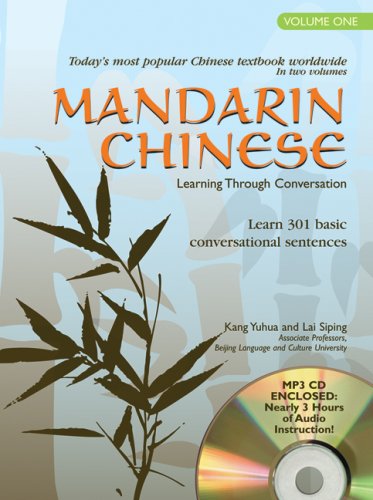Mandarin Chinese – Learning Through Conversation was originally published in China and has since been licensed for distribution by Barron's in North America. I was pretty excited when I first discovered this, as it seems as though there are so many high quality textbooks for learning Chinese that are not conveniently available outside of China. This textbook is a great choice for a beginner level Chinese course.
The structure of the course, which is carefully outlined at the beginning of the book, follows this basic structure:
-Key sentences
-Conversations
- Notes on usage
-Substitution and extension exercises
- New words
-Grammar
-More exercises
In addition to this, there are four review sections spread throughout the book, and a Chinese-English vocabulary at the end. The basic idea advertised by the course is to “Learn 301 basic conversational sentences”, which are numbered at the beginning of each of the twenty lessons. One should note that this first volume only presents the first 140 of these 301 sentences – the rest are contained in the second volume. This concept is a little silly, as learners will be able to produce a much greater number of sentences after using this book, considering how sentences can be manipulated. In any case though, the numbering of the sentences seems to be a harmless feature, and may help motivate students who like to gauge there progress quantitatively. The first few lessons also include explanations and exercises focusing on pronunciation, which is definitely a necessity when learning Chinese.
There are usually two to three conversations per lesson (not including those found in the exercises or review sections), and they are relatively short, covering all the essential topics, and gradually rising in difficulty as the lessons progress. All the conversations are given in Chinese characters and pinyin. One can find English translations for the key sentences given at the beginning of the lessons, but there are none for the conversations, which I think is a good thing, as it prevents students from using translations as a crutch. I don't really have any complaints about the conversations, aside from the fact that many of the sentences in them are rather short. While this is a more realistic reflection of how Chinese speakers are likely to communicate, giving longer sentences could have done more to serve the purposes of students trying to learn Chinese grammar.

I found the notes on usage and the grammar explanations to both be sufficiently informative and easy to understand. It is notable that all explanations in the book are given in Chinese, pinyin, and English, which provides the advantage of giving both students and teachers the ability to read these in their respective native language. One disclaimer I will make in regard to the explanations is that there are some grammatical terms tossed around which many not be readily understood by students, such as: “nominative predicate”, “adverbial adjunct”, “interrogative pronoun”, etc. Instructors should be able to sort through these explanations if any confusion occurs, but it may be a good idea to warn students beforehand that they may be encountering some jargon, so that they don't become frustrated later. There are some instances where it looks like the authors made some mistakes with their English, but it's never so bad that it created a misunderstanding.
"I think the exercises will provide the students a decent amount of practice to become familiar with the language, without making it tedious for them."
The substitution and extension drills are very short and simple, but I think they serve their purpose as exercises that can easily be done as a classroom activity or by students for homework. There is a wide variety of exercises found throughout the lessons with varying levels of difficulty. Some are as simple as “read these sentences until fluent” or “fill in the blank”, but others are more complicated, requiring students to create their own sentences, or listen to a passage then retell it in their own words. The bottom line is, I think the exercises will provide the students a decent amount of practice to become familiar with the language without making it tedious for them. Unfortunately, there is no answer key for the exercises, so students will have to rely on an instructor if they need help checking their accuracy.
Vocabulary is given in order of appearance, showing the word in Chinese characters, pinyin, and English, as well as the part of speech it falls under. I don't think there is really anything more to ask for as far as this section goes.
The book comes with a CD containing audio that goes along with the lessons. Audio is provided for every section of the book except for the explanations and exercises where listening is not involved (such as fill in the blank). The recordings are high quality and the speed is just about right for the beginning learner.

One thing I would say that is missing from this book is a focus on learning the Chinese characters. Students will have to rely on outside resources if they want to learn details about the characters, as there is nothing written about how they work, the components they are made up of, how to write them, or their history. I think that this is something that beginning Chinese students cannot do without, so instructors using this as their primary text will want to plan for the use of supplementary lessons and/or resources to make up for this deficiency.
Overall, for a text that bills itself as “The world's most popular Chinese textbook”, I would say that it is worthy of this title. I highly recommend its use for beginning learners, as long as it is supplemented with a resource for studying Chinese characters.





